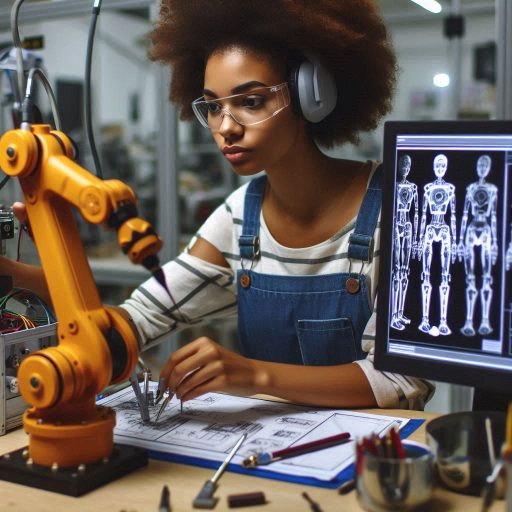Introduction
Robotics engineering is a dynamic and rapidly advancing field dedicated to the design, construction, and operation of robots across various industries.
From manufacturing to healthcare, robotics plays a critical role in enhancing efficiency, precision, and safety in countless applications.
As technology continues to evolve, robotics engineering is at the forefront of innovation, driving significant changes in how industries operate.
Understanding and keeping up with industry trends and insights in robotics engineering is essential for professionals and organizations aiming to stay competitive.
These trends not only shape the future of robotics but also influence how engineers approach challenges, develop new technologies, and implement solutions.
Insights into the latest advancements can provide valuable guidance on where the industry is heading and what skills or knowledge are necessary to succeed.
The purpose of this blog post is to delve into the most important trends in robotics engineering today.
We explore these trends to give a clear view of the current landscape.
Our goal is to offer actionable insights.
Professionals can use these insights to advance their careers or enhance their projects in this cutting-edge field.
History of Robotics Engineering
Origins of Robotics Engineering
The origins of robotics engineering trace back to early mechanical devices and automata.
Ancient civilizations created simple mechanical devices that could mimic human actions.
For instance, ancient Greek engineers designed complex water clocks and automated temple doors.
However, modern robotics engineering began to take shape in the early 20th century.
Early inventors and visionaries such as Karel ?apek and Isaac Asimov began defining robotics as a distinct field.
?apek coined the term ‘robot‘ in his 1920 play, ‘R.U.R.,‘ which envisioned humanoid robots performing labor.
Asimov‘s science fiction explored robots with advanced cognitive functions, laying a conceptual groundwork that influenced the field‘s direction.
Milestones in Development
Several key milestones mark the development of robotics engineering.
In 1961, George Devol and Joseph Engelberger introduced Unimate, the first industrial robot, which revolutionized manufacturing processes.
This robot could perform repetitive tasks, such as welding, with precision and speed.
The 1970s and 1980s saw further advancements with the introduction of more sophisticated robots.
Companies like Fanuc and KUKA pioneered robots with enhanced dexterity and programmability.
The 1990s marked the beginning of collaborative robots, or cobots, designed to work alongside humans safely.
The turn of the millennium brought significant breakthroughs with robots integrating artificial intelligence, machine learning, and advanced sensors.
Robots began to move beyond industrial applications to fields like healthcare, exploration, and service industries.
For example, surgical robots enabled minimally invasive procedures, and autonomous robots began exploring space and deep oceans.
Impact on Current Trends
Historical advancements have profoundly influenced current trends in robotics engineering.
Early innovations set the stage for the sophisticated robots we see today.
Modern robotics combines lessons from the past with cutting-edge technology.
Robots now incorporate advanced AI and machine learning, enabling them to perform complex tasks and adapt to changing environments.
Autonomous vehicles, drones, and smart home devices are direct descendants of early robotic principles.
The evolution of robotics technology has expanded its applications across various sectors, including manufacturing, healthcare, agriculture, and entertainment.
Understanding the history of robotics provides valuable context for current trends and future developments.
It highlights how foundational concepts have evolved into advanced systems, shaping the robotics industry‘s present and future landscape.
Read: Top Companies Hiring CAD Technicians in the USA
Current Trends in Robotics Engineering
Overview of the latest technologies and innovations
Robotics engineering is evolving rapidly, with cutting-edge technologies and innovations shaping the industry.
One of the key trends in robotics engineering is the integration of artificial intelligence (AI) and machine learning algorithms into robotic systems.
This allows robots to learn from their environment, adapt to new situations, and perform tasks more efficiently.
Another crucial trend is the focus on human-robot collaboration, where robots are designed to work alongside humans in various settings.
Collaborative robots, also known as cobots, are equipped with advanced sensors and safety features that enable them to interact safely with humans.
This trend is revolutionizing industries such as manufacturing, healthcare, and logistics.
Additionally, advancements in automation technologies are driving significant changes in robotics engineering.
Robotics systems are becoming more autonomous and capable of performing complex tasks with minimal human intervention.
This has led to increased efficiency, productivity, and cost savings for businesses across different sectors.
Automation, artificial intelligence, and machine learning
Automation is at the core of robotics engineering, enabling machines to carry out repetitive tasks efficiently and accurately.
In recent years, there has been a growing emphasis on incorporating AI and machine learning capabilities into robotic systems.
These technologies allow robots to analyze data, make decisions, and improve their performance over time.
Artificial intelligence plays a crucial role in enabling robots to perceive their environment, recognize objects, and navigate complex spaces.
Machine learning algorithms enable robots to learn from experience, adapt to changing conditions, and optimize their actions.
By integrating AI and machine learning into robotics engineering, companies can develop smarter, more autonomous robots that can handle a wider range of tasks.
Moreover, the use of automation, AI, and machine learning in robotics engineering is driving innovation in various industries.
From autonomous vehicles and drones to robotic surgery and warehouse automation, these technologies are transforming the way we work and live.
Companies that embrace these trends can gain a competitive edge and unlock new opportunities for growth.
Examples of companies leading the way in robotics engineering
Several companies are at the forefront of robotics engineering, pushing the boundaries of innovation and shaping the future of the industry.
One notable example is Boston Dynamics, known for its advanced humanoid and quadrupedal robots that demonstrate remarkable agility and intelligence.
The company’s robots have applications in research, industrial automation, and even entertainment.
Another leading player in robotics engineering is Fanuc, a Japanese company specializing in industrial robots and automation solutions.
Fanuc’s robots are widely used in manufacturing, automotive assembly, and other industrial settings due to their precision, speed, and reliability.
The company continues to develop new robotic technologies that improve efficiency and productivity in various industries.
Additionally, companies like Universal Robots and ABB are pioneering the development of collaborative robots that can work alongside humans safely.
These cobots are designed to assist with repetitive tasks, enhance worker safety, and increase overall productivity.
By partnering with these companies, businesses can leverage the latest advancements in robotics engineering to streamline operations and drive innovation.
Read: How to Build a Strong CAD Technician Portfolio
Industry Insights in Robotics Engineering
When it comes to Robotics Engineering, understanding market trends and growth opportunities is crucial for success.
Let’s delve into some key insights in the industry:
Analysis of Market Trends and Growth Opportunities
Market trends in robotics engineering are constantly evolving, driven by advancements in technology and changing consumer demands.
Growth opportunities in the industry are abundant, particularly in sectors like healthcare, manufacturing, and logistics.
Robotics engineers must stay abreast of market trends to identify opportunities for innovation and business development.
Emerging trends such as collaborative robots, AI integration, and IoT connectivity are shaping the future of robotics engineering.
Global market analysis forecasts significant growth in the robotics industry, creating new opportunities for engineers worldwide.
Challenges Faced by Robotics Engineers
One of the key challenges faced by robotics engineers is the need for continuous skill development to keep pace with technological advancements.
Complexities in design and programming, as well as interoperability issues, pose significant challenges in robotics engineering projects.
Cost constraints and budget limitations often hinder the development and implementation of advanced robotics solutions.
Regulatory compliance and ethical considerations are critical challenges that robotics engineers must navigate in their projects.
Competition in the industry is fierce, requiring robotics engineers to constantly innovate and differentiate their products and services.
Importance of Staying Updated on Industry Insights for Career Advancement
Being well-informed about industry trends and insights is essential for robotics engineers to stay competitive and relevant in the field.
Knowledge of market dynamics can help robotics engineers identify new opportunities for career growth and professional development.
Networking with industry experts and peers can provide valuable insights and open doors to new career opportunities in robotics engineering.
Pursuing advanced education and certifications in robotics engineering can enhance skills and expertise, leading to career advancement.
Continuous learning and staying updated on industry insights are key to staying ahead in the rapidly evolving field of robotics engineering.
Essentially, staying informed about market trends and understanding challenges drive success in Robotics Engineering.
Invest in career development to stay ahead in this dynamic field.
By proactively seeking industry insights, robotics engineers can unlock new opportunities and propel their careers to new heights.
Read: Best Online Courses for CAD Technician Training
Impact of Robotics Engineering on Various Industries
Revolutionizing Key Sectors
Robotics engineering is profoundly transforming several key sectors, including healthcare, manufacturing, and agriculture.
In healthcare, robotics technology is advancing surgical precision and patient care.
Surgical robots, such as those used in minimally invasive procedures, allow for greater accuracy and shorter recovery times.
Robots are also enhancing diagnostic capabilities and assisting in complex surgeries, thus improving overall patient outcomes.
In manufacturing, robotics has revolutionized production lines by automating repetitive and labor-intensive tasks.
This automation not only increases efficiency but also ensures consistent product quality and safety.
Robots can work around the clock, significantly boosting productivity and reducing the risk of human error.
Agriculture, too, is experiencing a robotics-driven transformation.
Precision farming robots can monitor crop health, manage irrigation, and optimize pesticide use.
These technologies contribute to higher crop yields and more sustainable farming practices by reducing resource waste and minimizing environmental impact.
Benefits of Robotics Technology
The integration of robotics technology offers a range of benefits across various industries.
One of the primary advantages is the increase in productivity.
Robots can perform tasks faster than humans, often with greater precision and fewer errors.
This boost in efficiency translates to higher output and reduced production times.
Additionally, robotics enhances workplace safety by taking over dangerous or monotonous tasks that could lead to injuries or health issues.
In environments where handling hazardous materials or working in extreme conditions is required, robots provide a safer alternative.
The cost-efficiency of robotics is another significant benefit.
While the initial investment in robotic systems can be high, the long-term savings are substantial.
Robots reduce the need for manual labor, decrease the likelihood of errors, and lower operational costs over time.
This cost-saving aspect is particularly important for businesses looking to remain competitive in a global market.
Future Projections
Looking to the future, robotics engineering is set to play a pivotal role in shaping the global economy.
As technology continues to advance, robotics will become increasingly integrated into various industries.
The development of more sophisticated robots with improved capabilities will drive innovation and create new market opportunities.
Industries will see continued advancements in automation, leading to more efficient and cost-effective processes.
Robotics technology will drive significant economic growth, creating jobs in robotics design, maintenance, and programming.
Moreover, as robots become more prevalent, they will contribute to solving global challenges, such as food security and healthcare access.
Robotics will transform industries and drive progress in tackling broader societal issues.
Robotics engineering will play a crucial role in the future economy.
Read: Future of CAD Technician Jobs in Engineering

Career Path in Robotics Engineering
Overview of educational requirements for aspiring robotics engineers
When considering a career in robotics engineering, there are specific educational requirements that aspiring professionals need to meet.
The typical path to becoming a robotics engineer involves obtaining a bachelor’s degree in a related field such as mechanical engineering, electrical engineering, or computer science.
Some employers may prefer candidates with a master’s degree or Ph.D. in robotics or a related discipline.
In addition to formal education, gaining hands-on experience through internships or co-op programs can be beneficial for aspiring robotics engineers.
These opportunities provide valuable practical skills and allow individuals to work on real-world projects, enhancing their employability in the field.
Transform Your Career Today
Unlock a personalized career strategy that drives real results. Get tailored advice and a roadmap designed just for you.
Start NowSkills needed to succeed in the field
To succeed in the field of robotics engineering, professionals need a combination of technical and soft skills.
Technical skills include proficiency in programming languages such as C++ and Python, as well as knowledge of robotics software and hardware systems.
Strong analytical and problem-solving skills are also essential for designing and troubleshooting robotic systems.
In addition to technical skills, robotics engineers should possess excellent communication and teamwork abilities.
Collaboration is often necessary when working on robotics projects, and effective communication skills ensure that team members understand project requirements and goals.
Adaptability and creativity are also valuable traits for robotics engineers, as they may need to think outside the box to develop innovative solutions.
Job prospects and salary potential in robotics engineering
Robotics engineers enjoy strong job prospects due to growing demand for automation and robotic technologies.
Industries like manufacturing, healthcare, and defense drive this need.
Advancements in artificial intelligence and machine learning position robotics engineers to drive cutting-edge projects and innovations.
In terms of salary potential, robotics engineers can expect competitive compensation based on their level of experience and expertise.
The Bureau of Labor Statistics reports that robotics engineers earned a median annual wage of $99,040 in May 2020.
The top 10% of earners made over $160,520 per year.
Salaries may vary depending on factors such as location, industry, and company size.
Lastly, a career in robotics engineering offers exciting opportunities for professionals interested in designing, developing, and implementing robotic systems.
With the right education, skills, and experience, aspiring robotics engineers can build successful careers in a dynamic and rapidly evolving field.
Learn More: Understanding Different Database Management Systems
Discover More: Top Networking Companies Hiring in 2024
Ethical Considerations in Robotics Engineering
As robotics engineering continues to advance rapidly, ethical considerations have become a crucial aspect of this field.
Ethical Dilemmas Related to Robotics Technology
One of the key ethical dilemmas in robotics technology is the potential for job displacement due to automation.
Robotics engineers must consider how their creations will impact the workforce and the economy as a whole.
There is also the ethical issue of autonomy and decision-making capabilities in autonomous robots.
Questions arise regarding who is responsible if a robot makes a harmful decision or causes harm to humans.
Importance of Responsible and Ethical Use of Robotics Engineering
Responsible and ethical use of robotics engineering is essential to ensure the safety and well-being of society.
By adhering to ethical principles, robotic engineers can minimize the risks associated with their creations.
Ethical considerations also play a crucial role in building trust between the public and robotics technology.
Being proactive in addressing ethical concerns can help prevent potential misuse of robotics technology.
Case Studies on Ethical Implications of Robotics Advancements
One notable case study is the use of drones in military operations and the ethical issues surrounding civilian casualties.
Another example is the development of autonomous vehicles and the ethical dilemmas related to decision-making in potential accidents.
Robotic surgeons raise ethical questions about accountability and the potential for errors during procedures.
Basically, case studies help highlight the importance of ethical considerations in robotics engineering.
You Might Also Like: Online Courses for Aspiring Chemical Engineers
Future Trends in Robotics Engineering
As the field of robotics engineering continues to evolve rapidly, it is crucial to look ahead and anticipate the future trends that will shape this industry.
In this section, we will explore predictions for upcoming robotics innovations and technologies.
We will also examine the impact of advancements such as quantum computing and bio-robotics.
Additionally, we will speculate on the future of robotics engineering as a field.
Predictions on Upcoming Innovations and Technologies
- Machine learning and AI integration for smarter robots
- Advanced sensor technologies for improved perception and interaction
- Nanorobotics for precision medicine and targeted drug delivery
- Swarm robotics for collaborative tasks and enhanced efficiency
- Exoskeletons for rehabilitation and assistance in various industries
Impact of Advancements like Quantum Computing and Bio-Robotics
- Quantum computing enabling faster computation for complex robotics tasks
- Bio-inspired robots mimicking natural movements and behaviors
- Integration of biological elements for enhanced robot capabilities
- Development of soft robots for delicate tasks and safe human interaction
- Use of biometric sensors for human-robot interaction and emotional intelligence
Speculation on the Future of Robotics Engineering as a Field
- Growth in interdisciplinary collaborations with fields like biology and psychology
- Increased focus on ethical considerations in robot design and deployment
- Rise of autonomous robots for various applications, including transportation and healthcare
- Customizable robots tailored to specific user needs and preferences
- Expansion of robotics industry into new sectors such as agriculture and construction
Essentially, the future of robotics engineering holds immense potential for groundbreaking innovations and revolutionary technologies.
Professionals who stay ahead of these trends drive progress and shape a world where robots increasingly integrate into daily life.
Conclusion
In this blog post, we explored various insights and trends in the field of robotics engineering.
We discussed how robotics is revolutionizing industries, enhancing productivity, and improving efficiency.
As we move towards a more automated world, it is crucial for professionals to stay informed about the latest advancements in robotics engineering.
By keeping up with industry trends, individuals can adapt and succeed in this fast-evolving field.
If you are passionate about technology, innovation, and problem-solving, a career in robotics engineering could be the perfect fit for you.
With the demand for skilled professionals in this field on the rise, there are ample opportunities for growth and development.
Aspiring robotics engineers should consider pursuing relevant education and training to acquire the necessary skills and knowledge.
By staying curious, proactive, and dedicated, individuals can carve a successful career path in robotics engineering.
Join the exciting journey of shaping the future with robotics engineering.
Stay tuned for more updates, insights, and opportunities in this dynamic industry.
Together, let’s drive innovation and create a smarter, more connected world through robotics engineering!




